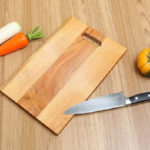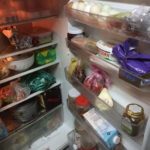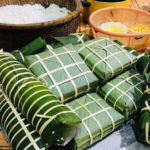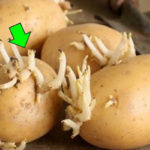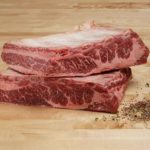Chung cake is one of the indispensable traditional Tet dishes of the Vietnamese people. However, this year’s Tet holiday has warm weather conditions, which facilitate the growth of mold. As a result, some families’ chung cakes have been attacked by mold. Can we still eat the remaining cake after cutting off the moldy part?
Can we still eat the remaining cake after cutting off the moldy part?
During Tet, families make a large quantity of chung cakes and keep them for a long time. The cakes are prone to mold in the corners, without spreading to the entire cake. You can cut off the moldy part and eat the remaining portions. However, note that while mold appears in one corner of the cake, some mold strains have the ability to ferment the cake and make it sour. Therefore, you need to cut a wider area around the mold, only taking the intact part of the cake, then steam or fry it carefully before eating.

If the mold has spread extensively, it’s better to discard the entire cake. The bacteria have already penetrated deep inside, and eating it can cause stomach pain and digestive disorders.
To store chung cakes, keep them wrapped in leaves and place them in the refrigerator. Cut only the portion that you want to eat, and cover the cut surface with plastic wrap. If the cake becomes dry, you can steam, fry, or reheat it before consuming. Chung cakes can be stored in the refrigerator for 7-10 days.
In general, it is best not to eat food that has mold since moldy food produces toxins.
What happens if you eat moldy food?
According to health experts, in most cases, consuming a small amount of moldy food will not affect your health. It can only cause illness in rare instances.
Fortunately, even if you accidentally eat a little moldy food, your body will be fine. The digestive system can process mold just like any other type of food. You will remain healthy as long as your immune system is functioning properly and capable of neutralizing the harmful effects of mold.
In reality, mold is a type of extremely small fungus that spreads onto food through air, water, or insects. While mold can be dangerous, it is mostly harmless. In some cases, individuals who consume moldy food may experience some discomfort. However, this discomfort is often due to the unusual taste and smell of mold rather than any specific toxin it produces.
After eating, pay attention to whether the symptoms are just normal slight nausea or more severe. Most molds have difficulty surviving in the stomach due to the high acidic environment. If you experience prolonged nausea or vomiting, it is advisable to see a doctor.
Although rare, there are cases of illness caused by consuming moldy food. When mold penetrates a food item, it is only on the surface. In reality, the mold’s roots may have already penetrated deep inside the food. Hence, for soft and porous foods like cakes, it is best to discard them when mold is detected. However, for certain hard foods like fruits or hard cheese, mold roots have a difficult time penetrating deep inside. It is entirely safe to eat these foods if you cut off the moldy outer part and consume the inner portion. The recommended safe eating distance is approximately 2.5 cm below the surface affected by mold, according to the U.S. Department of Agriculture (USDA) guidelines.
8 Common Mistakes People Make with Cutting Boards
Are you using your cutting board correctly? Many Vietnamese households rely on cutting boards in their kitchen, but not everyone knows how to use them properly, especially when it comes to wooden cutting boards. Check out these 8 mistakes to avoid when using a cutting board to ensure both hygiene and safety for everyone in your family.
Is Refrigerated Leftovers Linked to an Increased Risk of Cancer?
Dr. Lam Van Man, Head of Research, Development and Technology Transfer Department of the Institute of Safety Food, has warned of the risk of food poisoning when reheating leftovers from the refrigerator. But what should we be aware of when it comes to the possibility of these leftovers causing cancer? Here, we explore what the experts have to say on the matter and offer some tips for safe eating.
Preserving Leftover Food from the Tet Holiday
With the beginning of the Lunar New Year, many households are stocking up on food to celebrate the festive occasion. While keeping food in the refrigerator is convenient, it can also be harmful to users if not done correctly. We have compiled a few tips to help ensure food remains fresh and safe to consume during Tet.

























